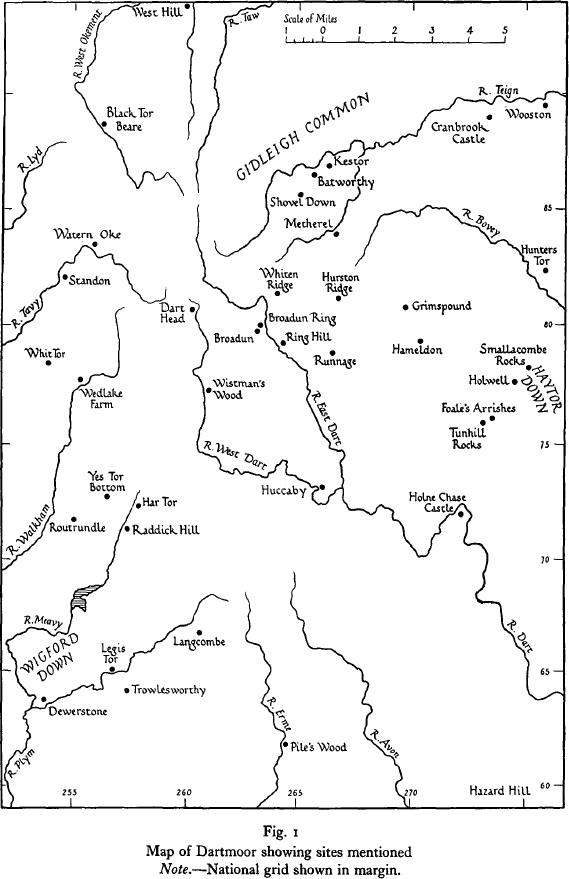Article contents
Prehistoric Settlements on Dartmoor and the Cornish Moors
Published online by Cambridge University Press: 27 May 2014
Extract
It is not my intention in this paper to deal with the whole field of antiquities found on the southwestern moors and I shall only refer to the sepulchral and other remains of a ritual character in so far as they have a direct bearing on the interpretation of the settlements (fig. 1). Inclusion of the Cornish moors is prompted by the fact that certain stages in the development of the settlements are not represented on Dartmoor but can be illustrated from the lower moorlands further west.

The material on which my interpretation is based is largely the result of work carried out by the Dartmoor Exploration Committee of the Devonshire Association. Beginning in 1894 this Committee, in addition to other work, explored some 20 settlements excavating nearly 150 hut circles. The objects discovered are mostly in the City Museum at Plymouth and some of the pottery is now illustrated for the first time. Most of the Committee's work was carried out in the first ten years of its existence, but the excavation of a site now flooded by the Torquay Corporation's reservoir was undertaken as late as 1933 and the Committee remained in existence until 1950, when the Association reconstituted its arrangements in respect of Dartmoor. As the last surviving member of the old Dartmoor Exploration Committee it is perhaps fitting that it should fall to my lot to interpret the results then obtained in the light of more modern knowledge and methods. The Association has kindly sanctioned the republication of figs. 4, 5, 6 and 9.
- Type
- Research Article
- Information
- Copyright
- Copyright © The Prehistoric Society 1953
References
page 55 note 1 The main thesis of this paper was put forward in opening the discussion of the paper written by the late Mr Hansford Worth to the Prehistoric Conference held at Exeter in 1949. In outline I had already developed this in 1932, see Congrés international des Sciences préhistoriques, 1932, p. 138Google Scholar.
page 57 note 1 Cf. the description of Moor, Bodmin in Phil. Trans. Roy. Soc. vol. 234, 399Google Scholar.
page 57 note 2 ibid., 440.
page 57 note 3 Transactions of the Devonshire Association (cited as TDA), LIII, 232Google Scholar.
page 58 note 1 Hencken, Archaeology of Cornwall and Scilly, chap. V.
page 58 note 2 Proceedings of the Devon Archaeological Exploration Society (cited as PDAES), III, 109Google Scholar.
page 58 note 3 PDAES, I, 40, 90, 162Google Scholar and II, 135.
page 58 note 4 PDAES, II, 244Google Scholar and III, 33.
page 58 note 5 Arch.J., CI, 20Google Scholar.
page 58 note 6 For an early unclassified list see Burnard, , Dartmoor Pictorial Records, IV, 9Google Scholar.
page 58 note 7 Museum of the Torquay Natural History Society.
page 58 note 8 Information from Mr C. K. C. Andrew, F.S.A.
page 58 note 9 Antiquity, XII, 460Google Scholar.
page 58 note 10 I am much indebted to Mr E. H. Rogers, F.S.A., who has recently classified the implements in this collection.
page 58 note 11 Dartmoor Pictorial Records, IV, 9Google Scholar.
page 59 note 1 TDA, LXXVII, 226.
page 60 note 7 TDA, LXXVII, 229.
page 61 note 1 For a summary with a number of typical plans, see TDA, LXXV, 273.
page 61 note 2 This feature distinguishes the prehistoric pounds from the early medieval enclosures (p. 75).
page 62 note 3 Plan: TDA, LXXV, 286; excavation report; TDA, XXVIII, 183; summary: ibid., 198.
page 61 note 4 The lyncheted enclosure recorded by Dr Curwen is not that which produced the early pottery (Antiquity, I, 284)Google Scholar.
page 63 note 1 The turf would weather out from this form of construction, leaving only the stones and heavier soil; confirmation can only be obtained where there is a sudden collapse leaving a block of turf at the foot of the wall, as in the enclosure of Finnian, Chapel, Wigtownshire, (Dumfries and Galloway Nat. Hist. and Antiq. Soc., 3rd series, XXVIII, 32 and 37)Google Scholar.
page 63 note 2 Excavation report: TDA, XXVIII, 191; summary: ibid., 198.
page 63 note 3 The description of this pound as ‘an arc, the chord of which is the bank of a stream’ (TDA, LXXV, 297)Google Scholar neglects the modern disturbance and erosion.
page 63 note 4 Excavation report: TDA, XXIX, 148.
page 64 note 1 The excavation report does not mention the modern modification and therefore differs from the description given in the text.
page 64 note 2 Antiquity, I, 27Google Scholar.
page 64 note 3 Excavation report: TDA, XXVI, 101; summary: TDA, XXVIII, 194.
page 64 note 4 Excavation report: TDA, XXVI, 189; summary: TDA, XXVIII, 196; cf. TDA, XXIII, 311. The pound at Broadun shows clearly on the air photograph.
page 64 note 5 TDA, XXVIII, 192.
page 64 note 6 TDA, LXXV, 284 and 292.
page 64 note 7 Plan: TDA, LXXV, 287; excavation report: TDA, XXX, 99.
- 6
- Cited by




